Introducción
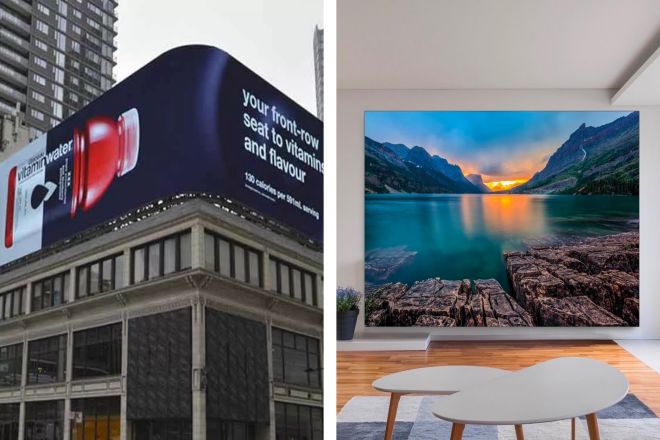
In today’s world, where digital technology is changing with each passing day, pantallas LED, an important medium for information display and visual communication, have penetrated every corner of our lives.
From the warm viewing in the family living room to the dazzling advertisements in the commercial district, LED display screens have become a bridge connecting the real and digital worlds with their unique charm and wide range of application scenarios.
However, there are significant differences between home and commercial LED display screens in terms of design, function, performance, and maintenance. This article aims to explore these differences in depth so that you can better understand the differences between the two so that you can make more informed decisions when choosing and using them.
1. Characteristics of home LED display screens
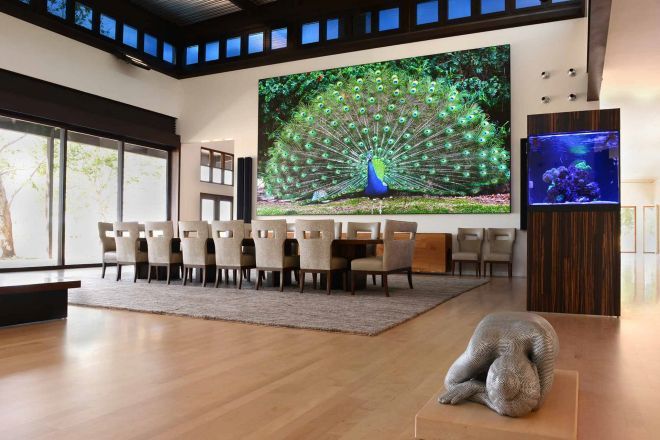
For Home LED display screens their characteristics are indeed more focused on the specific needs and scenarios of home use. Home LED display screens generally use small-pitch LED displays. The following are some more specific characteristics of home LED display screens:
1). Designed for home entertainment
High-definition picture quality: Home LED display screens usually use high-resolution panels to ensure that whether watching movies, TV series, or sports events, they can present delicate and clear pictures to enhance the home entertainment experience.
Color accuracy: In response to the needs of family viewing, home LED display screens pay more attention to color accuracy and naturalness in color adjustment, making color transitions smoother and color performance more realistic.
2). Comfortable viewing experience
Eye protection technology: In order to reduce the burden on the eyes from long-term viewing, home LED display screens are often equipped with eye protection mode, which reduces blue light radiation and protects the vision health of family members by adjusting parameters such as screen brightness and color temperature.
Intelligent adjustment: Some high-end home LED display screens can also automatically adjust the screen brightness according to ambient light to ensure the best viewing effect under different lighting conditions while reducing energy consumption.
3). Flexible installation and placement
Wall-mounted design: Home LED display screens mostly adopt a wall-mounted design, which saves space and is beautiful and generous. It can be easily installed on the wall of the living room or bedroom and integrates with the home environment.
Mobile bracket: Some small home LED display screens are also equipped with mobile brackets, which are convenient for users to adjust the screen position and angle according to viewing needs, and achieve a more flexible viewing experience.
4). Smart interconnection and convenient operation
Smart system: Some home LED displays have built-in smart systems that support smart interaction methods such as voice control and gesture recognition. Users can control the screen playback content through simple voice commands or gesture operations to improve its convenience.
Multi-screen interaction: Supports the screen projection function of smart devices such as mobile phones and tablets. Users can project videos, photos, and other content on their mobile phones to the LED display with one click to share wonderful moments with their families.
2. Characteristics of commercial LED display screens
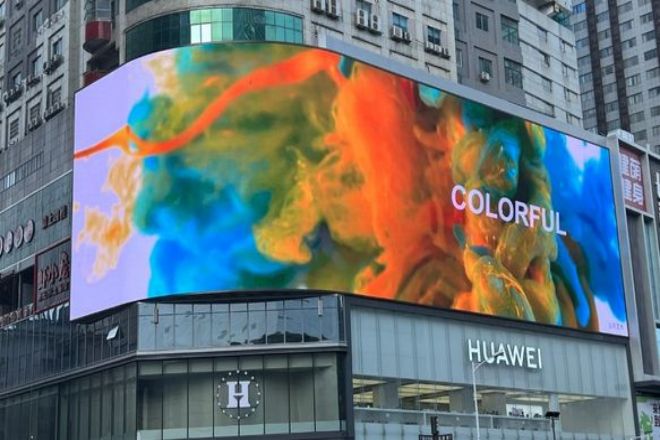
Commercial LED display screens play an important role in commercial advertising, information dissemination, public display, and other fields. The type of display screen is determined according to its installation. Its characteristics are mainly reflected in the following aspects:
1). High brightness and bright colors
High brightness: The brightness of commercial LED display screens is usually much higher than that of home products, and can maintain clear display effects in various light environments, especially in outdoor or indoor environments with strong light, and can still attract the attention of the audience.
Bright colors: Commercial LED display screens have high color reproduction and rich colors, which can provide more realistic visual effects, helping to enhance brand image and product promotion effects.
2). Large size and high-resolution
Large size: Commercial LED display screens are usually large in size, which can meet the needs of large-scale advertising display and information dissemination, especially in public places such as commercial centers, stadiums, and transportation hubs. Large-size display screens can attract more people’s attention.
High resolution: High-resolution display screens can present more delicate and clear pictures, making advertising content more vivid and realistic and enhancing the audience’s visual experience.
3). Stability and durability
Stability: The performance of commercial LED display screens is stable and is not affected by environmental factors such as temperature and humidity. It can operate stably for a long time to ensure the continuous display of advertising content.
Durability: Commercial display screens usually use high-quality LED lamp beads and advanced circuit design, with high durability and impact resistance, and can withstand frequent use and various challenges during transportation.
4). Real-time update and remote control
Real-time update: Commercial LED display screens can update display content in real-time, which is convenient for merchants to flexibly adjust advertising content according to market changes and promotion needs and improve advertising effects.
Remote control: Many commercial LED display screens support remote control functions. Users can remotely modify and update advertising content through the network without on-site operation, which greatly improves work efficiency and flexibility.
5). Diversified applications and customized services
Diversified applications: Commercial LED displays are widely used in commercial advertising, stadiums, stage performances, conference centers, public information releases, and other fields to meet the display needs of different occasions.
Customized services: Many commercial LED display providers provide customized services, which can customize the size, shape, resolution, brightness, and other parameters of the display according to the specific needs of customers, as well as provide personalized software solutions and after-sales services.
3. Comparison of commercial and home LED displays
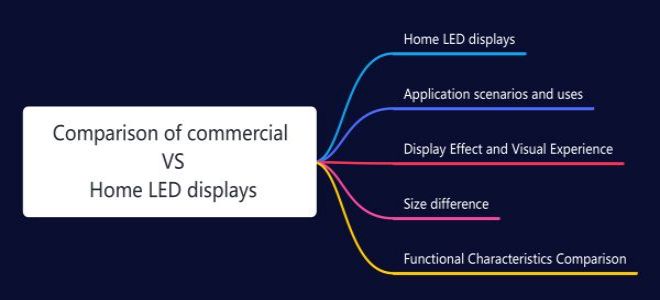
1). Size difference
1.1). Home LED display
The size design of the home LED display fully considers the limitations of family space and the convenience of personal use. Because the area of each family is different, the size of the LED display should be considered according to the use area.
The home LED display is mainly used in home entertainment and light office places, such as living rooms and bedrooms. In these scenes, users pursue a comfortable viewing experience and high-quality display effects.
1.2). Commercial LED display
The size of commercial LED displays is generally larger than that of home products, usually more than 100 inches, and can even reach hundreds or thousands of square meters.
This large-size design is mainly to meet the display needs of large commercial venues, ensuring that advertisements, information, and other content can be clearly seen at a distance while creating a strong visual shock effect. The extra-large size of commercial LED displays not only improves the efficiency of information dissemination but also enhances the brand image and product appeal.
Commercial LED displays are widely used in various commercial places, such as offices, conference rooms, shopping malls, hotels, and outdoor billboards. In these scenes, commercial LED displays not only bear the functions of information dissemination and advertising but also become an important element to enhance the grade of the place and create an atmosphere.
2). Functional Characteristics Comparison
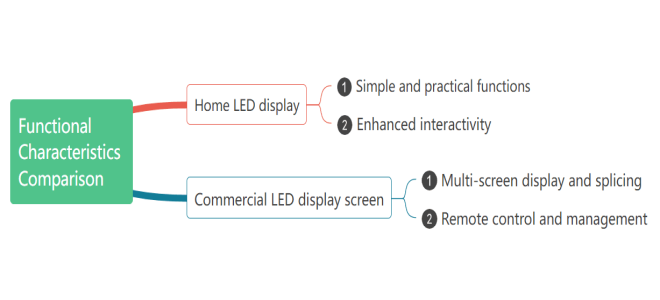
2.1). Home LED display
- Simple and practical functions:
The main functions of home LED displays are concentrated on home entertainment, such as watching high-definition movies and TV programs and playing games. These displays focus on the accuracy of color reproduction and the stability of refresh rate to ensure that users can enjoy smooth and realistic visual effects during viewing.
The accuracy of color reproduction allows users to feel more realistic picture colors, while the high refresh rate reduces the screen smear and blur, improving the overall viewing experience.
- Interactividad mejorada:
With the development of smart home technology, some high-end home LED displays have begun to support touch operation and smart interconnection functions. Touch operation allows users to operate directly on the screen with their fingers, such as adjusting the volume, switching channels, etc., which greatly improves the convenience of use.
The smart interconnection function allows users to connect mobile phones, tablets, and other devices to the display screen to achieve operations such as screen projection and remote control, further enriching the diversity of home entertainment.
2.2). Commercial LED display screen
- Multi-screen display and splicing:
Commercial LED display screen supports multiple screens spliced into a large display wall. This design enables it to adapt to various complex commercial display scenarios.
Whether it is the background wall of a large conference room, a promotional advertisement in a shopping mall, or a huge outdoor billboard, commercial LED display screens can achieve seamless connection through splicing technology to form a shocking visual effect.
At the same time, the multi-screen display function also supports a variety of screen layouts and split-screen displays to meet different display needs.
- Remote control and management:
Commercial LED display screens are usually equipped with a remote control and management system, allowing users to centrally control and manage multiple display screens through the network.
This remote control capability not only improves work efficiency but also facilitates users in updating display content, monitoring display status, and troubleshooting at any time. In large commercial venues, this remote management function is particularly important to ensure the stable operation of the display screen and the timely dissemination of information.
3). Display Effect and Visual Experience
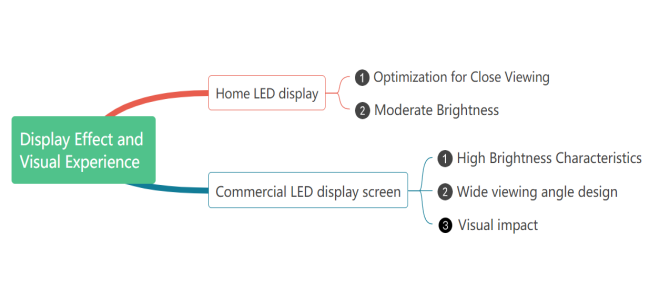
3.1). Home LED Display Screen
- Optimization for Close Viewing:
Home LED displays are designed for home entertainment and focus on the comfort of close viewing. They provide users with a more vivid and realistic viewing experience by optimizing color saturation and picture fineness.
The increase in color saturation makes the colors in the picture more vivid and full, while the increase in picture fineness makes the details of the image more clear and discernible, thereby enhancing the overall visual enjoyment.
- Moderate Brightness:
The brightness of the home LED display screen has been carefully adjusted to ensure that it will not be too glaring when viewed in a suitable home light environment while maintaining the brightness and clarity of the picture. This moderate brightness design helps to reduce visual fatigue caused by long-term viewing and protects the user’s eye health.
3.2). Commercial LED Display Screen
- High Brightness Characteristics:
Commercial LED displays perform well in terms of brightness, especially outdoor displays, which can reach 8000cd/m² or even higher. This high-brightness design ensures that the display screen can still remain clearly visible in strong light environments such as direct sunlight, ensuring the effective dissemination of information.
At the same time, high brightness also enhances the visual impact of the picture, making advertisements or information more eye-catching.
- Wide viewing angle design:
Commercial LED display screens usually have a wide viewing angle range, with an indoor viewing angle greater than 160 degrees and an outdoor viewing angle greater than 120 degrees.
This design allows viewers to clearly see the content on the display screen at any angle, meeting the needs of multi-angle viewing in large commercial venues. The wide viewing angle design not only improves the audience’s viewing experience but also increases the range of information dissemination.
- Impacto visual:
Commercial LED display screens create a strong visual impact through high brightness, high contrast, and rich color performance.
High contrast makes the light and dark parts of the picture more distinct, enhancing the three-dimensional and layered sense of the picture, while rich color performance makes the picture more vivid and colorful, attracting the audience’s attention.
This strong visual impact helps to enhance the brand image, attract customer attention, and promote sales.
4). Application scenarios and uses
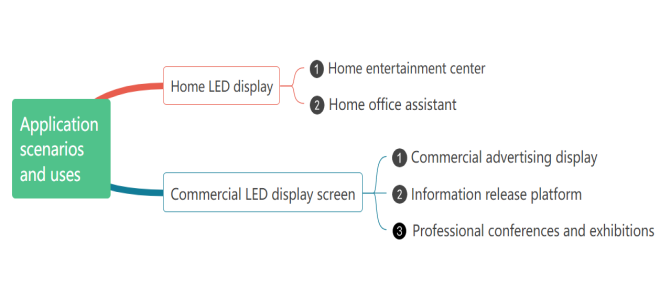
4.1). Home LED display screen
- Home entertainment center:
Home LED display screens play a core role in home entertainment. As the main screen of a TV or game console, it can provide high-definition, colorful, and smooth viewing and gaming experience. Whether watching movies or TV series or playing the latest games, home LED display screens can bring immersive visual enjoyment to users.
Its excellent color reproduction ability and high refresh rate ensure that the picture is delicate and without smear, creating a home entertainment center like a private theater for users.
- Home office assistant:
With the rise of remote work, home LED display screens have also become an important assistant for the home office. It supports high-definition video conferencing, allowing users to communicate clearly with colleagues and customers at home.
At the same time, its large screen design also facilitates users in handling office tasks such as documents and tables, improving work efficiency. In addition, some high-end home LED display screens are also equipped with touch and smart interconnection functions, further enhancing the convenience and intelligence level of a home office.
4.2). Commercial LED display screen
- Commercial advertising display:
Commercial LED display screens have a wide range of applications in the field of commercial advertising. They are installed in crowded areas such as commercial blocks, shopping malls, and stations to display advertising content through dynamic and high-definition images to attract the attention of passers-by.
The high brightness, wide viewing angle, and bright colors of commercial LED display screens enable them to maintain clear display effects in various environments, thereby effectively improving brand exposure and advertising effects.
- Information release platform:
Commercial LED display screens are also often used as information release platforms. Public transportation hubs such as aeropuertos and subway stations can publish important information, such as flight information, train schedules, weather forecasts, etc., in real-time so that passengers can keep abreast of relevant information.
This real-time information release function not only improves the level of public services but also enhances the travel experience of passengers.
- Professional conferences and exhibitions:
Commercial LED displays also play an important role in conference rooms, exhibition halls, and other places. They can display important data and charts to help participants better understand and analyze information.
The high resolution and color accuracy of commercial LED displays ensure the clear presentation of charts and data, which helps to assist decision-making and communication. At the same time, its large screen design is also convenient for multiple people to watch at the same time, which improves the efficiency and effectiveness of meetings.
Conclusión
In summary, home and commercial LED displays show obvious differences in size, functional characteristics, display effects, application scenarios, and cost maintenance.
Home users pursue high image quality, convenient operation, and comfortable viewing experience, while commercial users pay more attention to large size, high brightness, high stability, and professional information release and management capabilities.
Therefore, when purchasing LED displays, we should make comprehensive considerations based on our actual needs and usage scenarios to choose the most suitable product for ourselves.
Finalmente, si quieres saber más sobre las pantallas LED, Por favor póngase en contacto con nosotros.
